For the PMP Certification Exam, you will need to be able to compare the project management plan with the work performance information to determine whether any change requests are required.
In context of reviewing performance, a change request can be
Corrective action
Preventive action
Defect repair
If a change request is initiated, it will go to the Perform Integrated Change Control process. Regardless of any changes requested, the project management plan and the project documents are updated to reflect the current project status.
Work performance reports
The three aspects of reporting performance are progress reporting, status reporting, and forecasting.
Progress reporting: Identifies the activities and progress that have taken place since the last progress report. This includes the scope that has been completed, the schedule work that has been accomplished, costs that have been incurred, and any significant milestone achievements.
Status reporting: Describes the state of the project overall. For example, a status report might indicate that you have accomplished 50 percent of the project work, spent 55 percent of the project funds, and are 20 months into a 36-month project.
Forecasting: Attempts to predict future accomplishments for scope and schedule and future expenditures. A forecast report will often identify an updated finish date and an updated cost estimate.
Performance report data
The information in the reports is identified in the communication management plan. The information and the method of presentation will vary by audience. At the very least, all performance reports should include
Work completed in the current period
Work planned for completion but not complete, along with the reason(s) why
Funds expended during the current period
Any variance in the funds expended, along with the reason(s) why
Any corrective or preventive actions taken
Status of existing risks and issues
Any new risks or issues
Forecast for future schedule performance
Forecast for future cost performance
Resource utilization variances
Summary of changes requested and their status
Any quality findings
New and resolved assumptions
Reporting methods
In addition to the performance report, you can develop more visual charts and reports, such as
Trend charts
Tabular
Bull’s eye charts
Stop light charts
Dashboards
Knowledge and skills in reporting procedures is one of the areas that will be tested on the exam. Work performance reports are the primary outputs that will be used to test your knowledge and skills for reporting procedures.
Here are some examples of the types of information you can find in work performance reports.
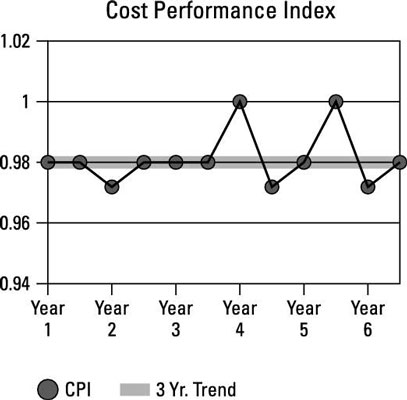
This bull’s eye chart shows performance of the project by plotting the schedule performance index (SPI) and CPI. This chart shows that Project E is in the worst shape, while D and F are performing better than expected. Projects C and F are the closest to plan of all the projects.
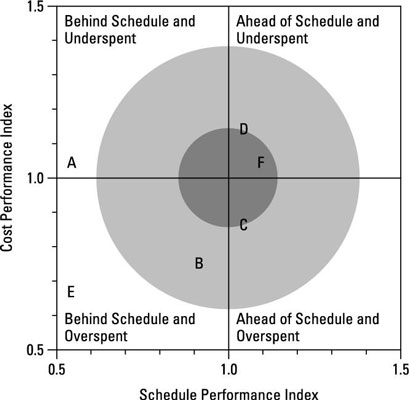
Some other types of charts include
Stop light charts
Dashboard reports
S-curve
The stop light chart indicates project status green (medium gray) if performing well within the threshold (0%–5% variance), yellow (light gray) if within the threshold but getting close to going beyond it (5%–10% variance), or red (dark gray) if over the threshold.
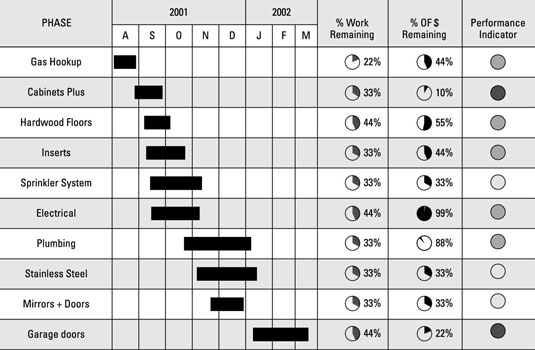
The dashboard report uses a series of gauges that show performance, using colors from a stop light chart or using other information to show performance.
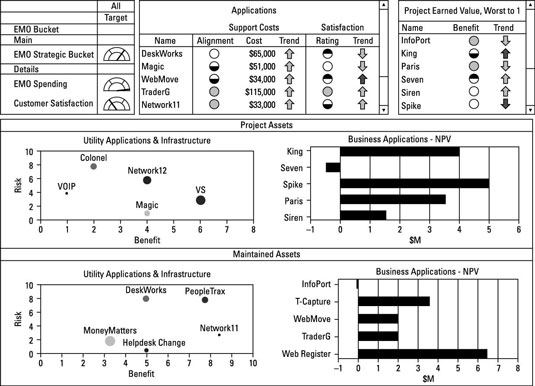
The S-curve is a common way to compare the planned value (PV), earned value (EV), and actual cost (AC) data for a project using earned value management.
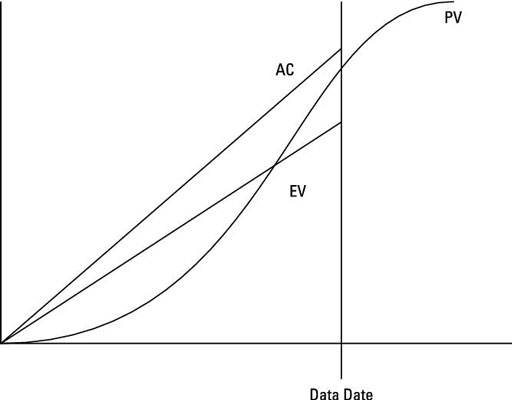
In general, graphics that highlight the outliers are useful for senior executives. The project manager and the team should look at detailed tabular reports and variance analysis reports to understand the reasons behind the outliers.
Depending on your work performance, you may need to update or change components in your project management plan or project documents.
The Monitor and Control Project Work process requires you to have knowledge and skills in the following areas to pass the exam:
Project control limits (thresholds and tolerances for scope, schedule, cost, and quality)
Project performance metrics (effort, duration, and cost)
Controlling performance against the project management plan
The honesty standards in the Code of Ethics and Professional Conduct are more relevant to the Report Performance process than any other process. There are many ways to misrepresent information in a performance report or leave out information that could reflect poorly on the project. You are likely to see scenario questions that address honesty standards and performance reporting on the PMP.
The following are honesty standards from the Code of Ethics and Professional Conduct:
Earnestly seek to understand the truth.
Be truthful in communication and conduct.
Provide accurate information in a timely manner.
Do not engage in or condone behavior that is designed to deceive others, including but not limited to, making misleading or false statements, stating half-truths, providing information out of context or withholding information that, if known, would render statements as misleading or incomplete.

